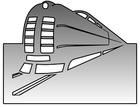Shanghai Street View: Retiring Trains

A major overhaul of China’s railway timetables has been in the news these last few days, part of an ongoing transformation that is changing the nature of how people use trains in this country. Amid all the adjustments making headlines, one report on the retirement of a 30-year-old route between Shanghai and Beijing caught my attention as it nicely summarized the huge changes that have occurred here over the last decade.
The rail system in China today is far different from the one I used when I first came to the country in 1987, just 3 years after the official launch of train #1462 that has been a workhorse on the Shanghai-to-Beijing route for the last 3 decades. Back then riding the trains was the main mode of long-distance travel, especially for longer trips between provinces.
Plane travel was a luxury for only the most privileged people in the 1980s and even the early ‘90s. Back then even trains were a luxury for many ordinary people, who did most of their travel on long-distance buses that one of my sisters once likened to the bombed out vehicles we sometimes saw on TV after terrorist attacks in the Middle East during the 1970s and ‘80s.
Today those rickety buses have disappeared completely, replaced by a new generation of long-distance coaches that are closer to what you see in many western countries. Plane travel is also accessible to nearly everyone, though it’s not uncommon to see people still opt for a 20-hour train or bus ride just to save an extra 100-200 yuan from the cost of a plane ticket.
But let’s return for a moment to train #1462, which made its final run from Shanghai to Beijing on June 30. The route logged quite an impressive record over that time, officially transporting 74 million people and winning the prestigious “Red Flag” train award several times.
I suspect the actual number of people who traveled on #1462 was probably much higher than the official tally, since many passengers in an earlier era often got aboard with standing room and platform tickets that probably weren’t counted in the official numbers. Such riders were often as numerous as actual ticketed passengers in the 1980s and ‘90s, and I can vividly recall riding in hard seat carriages crammed with people occupying every possible space from the aisle floors to the area around the toilets.
I had to smile when I read that #1462 was classified as a pukuai service, one of three rankings used back then to designate the frequency of stops for individual train routes. The fastest trains with the fewest stops were tekuai, or “especially fast.” Zhikuai trains were in the middle, taking you to your destination in “directly fast” manner. And then there was pukuai, or “ordinary fast”, which stopped in every small town and village along their routes and meant that even the shortest distances might take hours.
I had to do a little of my own research to see just how slow train #1462 was, since the report I saw didn’t mention any time. I wasn’t surprised when I finally found out it took a full 21 hours to reach Beijing, compared with 14 hours for the “direct fast” service and 5-6 hours for today’s high-speed rail service.
But then I also noted that a ticket to Beijing on #1462 cost just 88 yuan, versus 179 yuan for the “direct fast” and more than 500 yuan for a ticket on today’s high-speed rail. I’m sure many retirees with lots of time and limited budgets still favor “ordinary fast” trains like the #1462, and many of my students will also often take such slower trains to save some money.
My own memories of taking those older trains in the 1980s are quite checkered. On the one hand, you could always meet interesting new people on the trains, since everyone traveled by rail back then. But the lack of air conditioning, combined with long rides, lack of entertainment and thick clouds of cigarette smoke that filled most carriages made such travel less fun and usually a mixed experience at best.
Fast forward to today, when thousands of kilometers of high-speed rail now crisscross China, cutting travel times like the 21-hour odyssey on #1462 by half or more. The bigger picture, of course, is that no one wants to spend the night on a train anymore unless they have no other alternatives. That explains why trains like the #1462 are probably destined for extinction over the next few years.
Some people may feel a sense of nostalgia at the loss of these lumbering dinosaurs, and super budget-conscious travelers will almost certainly despair at the disappearance of this economical form of transport. But personally speaking, I won’t miss these old trains at all when they finally disappear, and am quite happy to see them relegated to the history books where they rightly belong.
